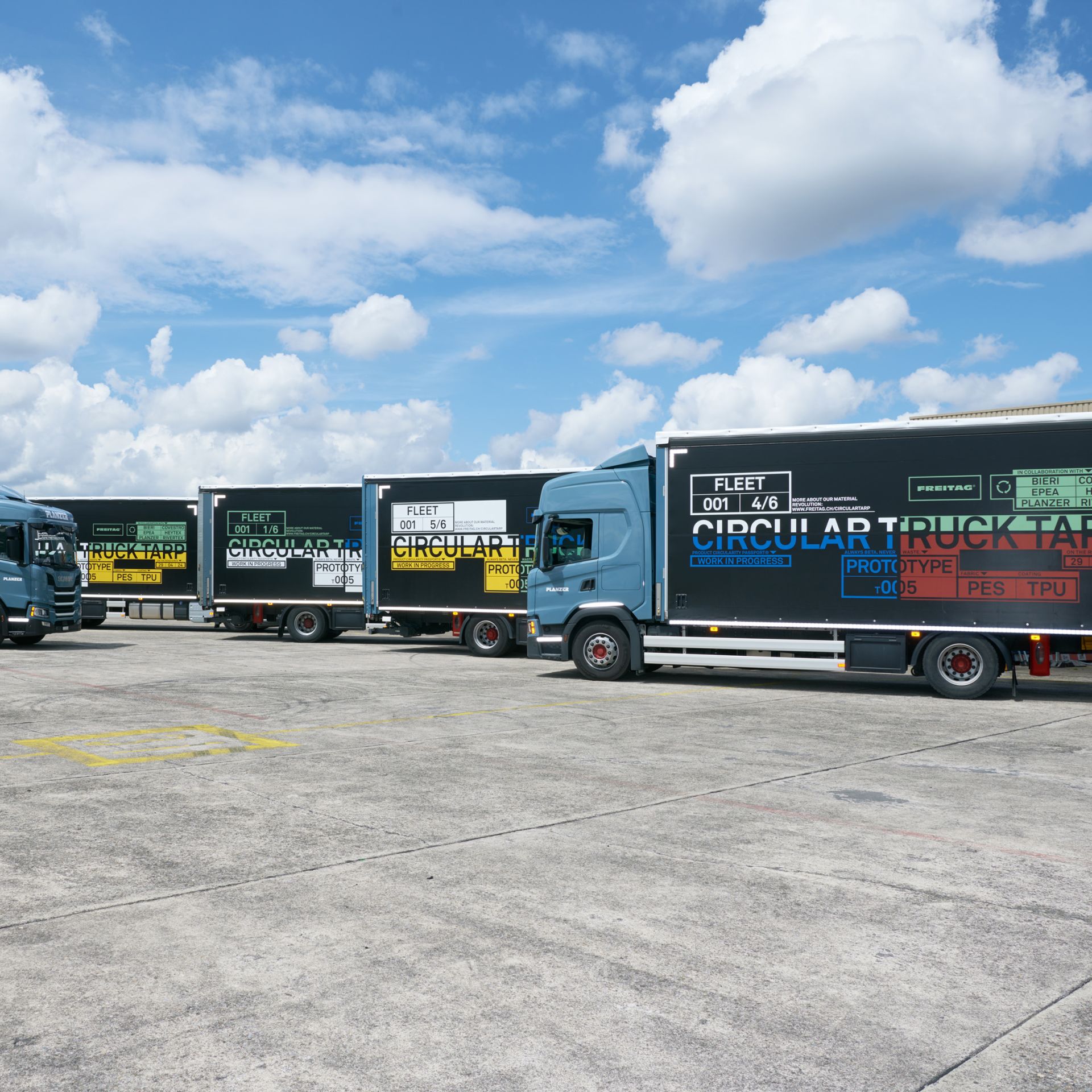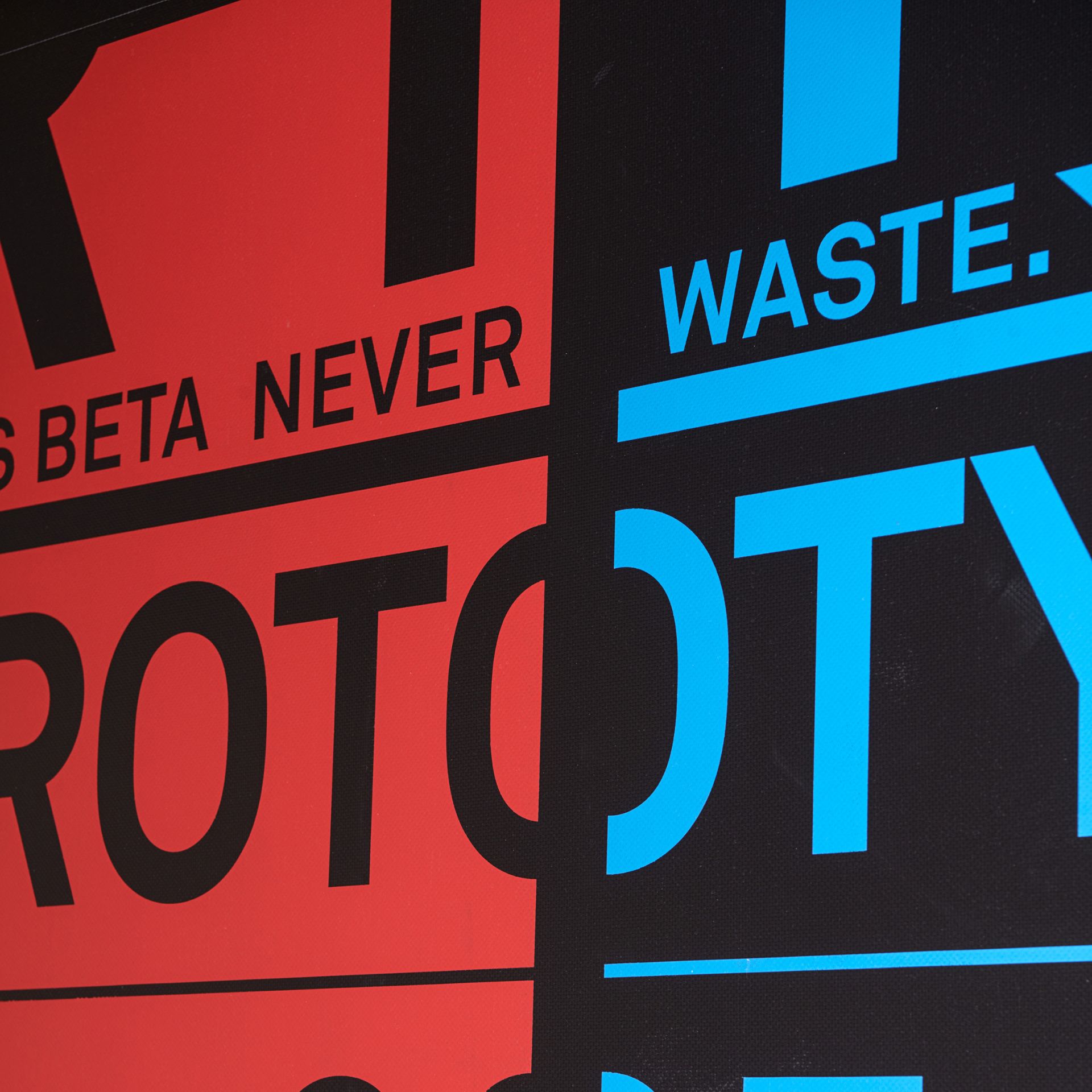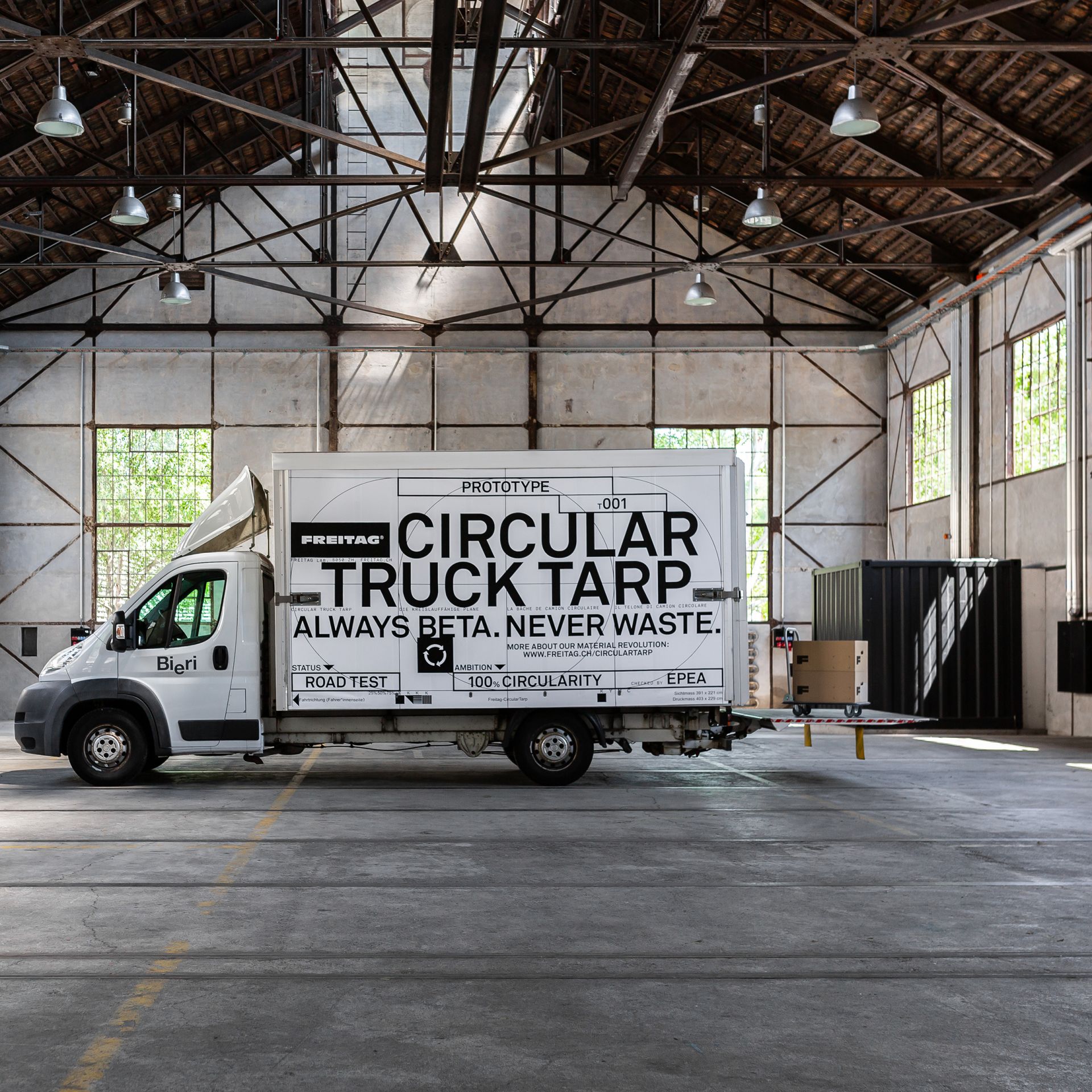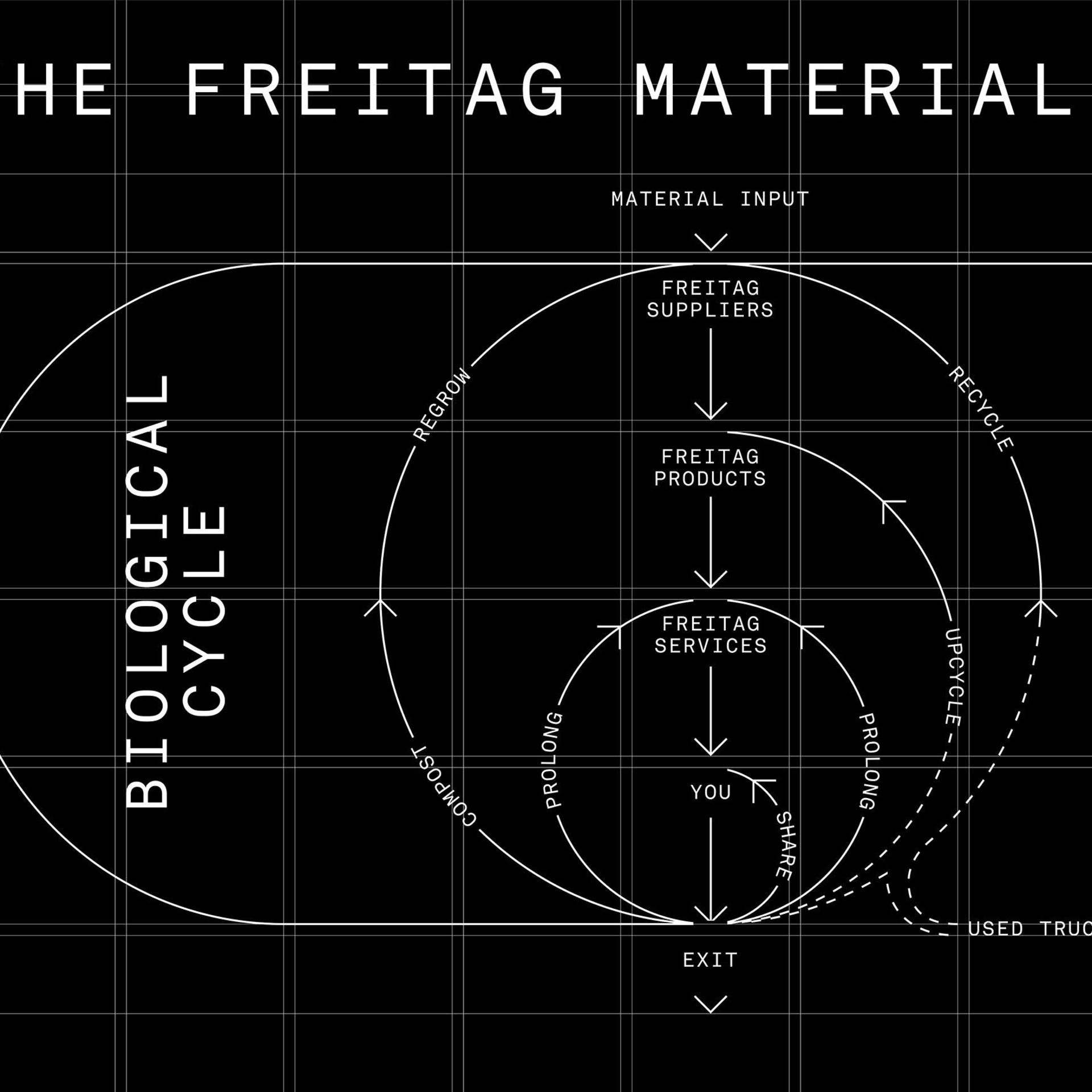CREDITS
Please mention the photo credit (see image caption)












Media release: Oktober 1, 2025
FROM HIGHWAY TO BAG FACTORY: FIRST CIRCULAR TARPS FACE FREITAG ENDURANCE TEST
Together with industry partners, FREITAG is developing a circular truck tarp that can be recycled after completing its second life as a FREITAG bag and thus ends up back in the loop. In 2024, a fleet of six trucks set off for a long-term road test – now, the first tarps have returned to the FREITAG headquarters in Zurich-Oerlikon. There, they are being tested for their suitability as bag material: from the cutting table to the wearable prototype.
FREITAG thinks and acts in cycles. This corporate philosophy manifests itself time and again in the successful closing of cycles. The most recent example was the Mono[PA6] Backpack, the first recyclable FREITAG backpack made without truck tarp from a single material. But one question arises again and again: What will it take to ensure that the truck tarps used to make most of the iconic bags and accessories will one day be circular and no longer end up as waste?
The answer is as simple as it is challenging: FREITAG will develop a circular truck tarp. And it will do that with various industrial partners in the materials, chemicals and composite sectors, as well as manufacturers, logistics companies and institutions in the materials-testing sectors and recycling industry. They all share the same vision and see the potential of the circular economy, which is why they work collectively and financially independently of each other. FREITAG is a practice partner of the Circular Lab, an initiative of the Wissenschaftsverbund Vierländerregion Bodensee (Lake Constance Arts & Sciences Association) supported by the Swiss federal government and the EU.
The big road test
As early as fall 2022 – just over two years after the project launch and one year after material development began – the first tarp prototypes were sent out for a test run. In the summer of 2024, FREITAG, together with its production partners and the logistics company Planzer, reached another milestone: six trucks and five trailers were fitted with further developed, circular tarps. Two material combinations are on the road in the test fleet: tarps made from a polyester fabric (PES) coated with a thermoplastic polyurethane (TPU), and mono-material tarps with both fabric and coating made of polypropylene (PP). More information on the two test fleets and material streams can be found in the press release from September 2024.
First road-tested tarps arrive at the FREITAG factory
To best document the effects of a hard life on the road on the tarps, the test samples are on the move for staggered periods. Some will continue to serve in logistics for months or even several years, while others have since returned to FREITAG.
At the bag manufacturer's factory in Zurich-Oerlikon, the road-tested tarp material is now being examined for its suitability for upcycled bags.
From circular Tarp to test bag
During the test phase, the upcycling process for the Circular Tarps at FREITAG involves five steps:
- First, the Digital Product Passport of each tarp is scanned. It contains information on the material, manufacturer, and the duration of the test phase.
- On the cutting table, the tarps are disassembled into machine-washable pieces.
- Each tarp is washed. FREITAG uses rainwater collected from the factory roof.
- Using knives and a laser cutter, the bag designers cut components for two classic FREITAG bag models from the Circular Tarps: F40 JAMIE and F41 HAWAII FIVE-0.
- The cut pieces are sewn into the first one-of-a-kind bags – initially in the FREITAG prototyping atelier in Zurich, and later on a trial basis with sewing partners.
Endurance test in everyday life
Around 40 one-of-a-kind messenger bags have been completed and distributed to testers. They are now evaluating the tarp material in bag form for its everyday usability. The focus is on the material properties: How robust, flexible, and water-repellent are the bags really? How does the material behave under intensive use? From this, FREITAG also hopes to find answers as to whether one of the two materials is better suited for bags than the other. The test phase will extend over several months.
Recycling as the final step
The very last step on the path to circularity is recycling. Ultimately, after their second life as FREITAG bags, the innovative tarps are intended to become truck covers once again – over and over. Regarding the recyclability of the PES/TPU tarp, initial tests for the mechanical recycling process have recently begun with the materials specialist Covestro. The reprocessing of polypropylene, which the PP/PP tarp is made of, is already offered by various recycling companies. FREITAG is currently searching for a suitable partner.
Bio-Based Tarp and Other Material Approaches
In addition to the two tarp types undergoing endurance testing, promising progress is being made with another material approach: the bio-based tarp. It consists of a cellulose-based fabric with a biopolymer coating. Three players have joined forces for its development: MehlerHeytex, a brand of Freudenberg (formerly Heytex) and a specialist in technical textiles, produces the cellulose fabric. The plastics manufacturer Linotech supplies the granulate for the coating. The "formula" for the tarp was developed at the FILK Freiberg Institute GmbH. In 2025, the crucial step from the laboratory phase to production on a test plant was taken. Provided the material quality meets the requirements, an industrial scale run is set to follow soon.
Furthermore, FREITAG is keeping an eye on two other material approaches in the market: mono-material tarps with fabric and coating made of PET or TPU, respectively. Various players are working on these two approaches, but no project is ready for testing yet.
CREDITS
Please mention the photo credits (see caption)















Media release: September 4, 2024
Now out on the road: The first truck test fleet with circular tarps
Together with industry partners, FREITAG is developing a circular truck tarp that can be recycled after completing its second life as a FREITAG bag and thus ends up back in the loop. The first prototype has now completed its two-year test drive on a delivery van. At the same time, work continued apace on various material combinations. Both are bearing fruit: A fleet of trucks fitted with circular tarps recently has been undergoing an endurance test on the road.
FREITAG thinks and acts in cycles. This corporate philosophy manifests itself time and again in the successful closing of cycles. The most recent example was the Mono[PA6] Backpack, the first recyclable FREITAG backpack made without truck tarp from a single material. But one question arises again and again: What will it take to ensure that the truck tarps used to make most of the iconic bags and accessories will one day be circular and no longer end up as waste?
The answer is as simple as it is challenging: FREITAG will develop a circular truck tarp. And it will do that with various industrial partners in the materials, chemicals and composite sectors, as well as manufacturers, logistics companies and institutions in the materials-testing sectors and recycling industry. They all share the same vision and see the potential of the circular economy, which is why they work collectively and financially independently of each other. The search for the tarp of the future, which can one day be broken down into its basic constituents and recycled, was officially launched in fall 2021. Just one year later, the first prototypes were mounted on a delivery van and sent out on a two-year test drive. These pioneering tarps recently completed their maiden voyage, returned to FREITAG and are now providing valuable insights into the properties of the material and its recyclability.
First truck test fleet on the road
Meanwhile, the search for the perfect material continued in the background, and the work is bearing fruit: two sub-projects are now ready for the endurance test. And that’s why the circular tarps are now traveling around in convoys. In Planzer, a Swiss logistics company, FREITAG has found a partner in the road freight industry that fitted out six of its trucks and five trailers with two different test tarps. These will be on the road for varying lengths of time. By staggering the test periods, the material’s aging process can be tracked more precisely under everyday conditions. Thanks to the large amount of material involved, it will soon be possible to test downstream bag production steps, such as washing, cutting, and sewing at FREITAG, as well as the necessary approaches to recycling. Bieri Tenta AG, who are responsible for printing using the stencil printing process and equipping the tarps, invested many hours in extensive material tests to ensure they could be processed and carry signage. The made-to-measure tarp company drew on its extensive supplier network to realize the test fleet. Certain PES/TPU-compatible accessories were unavailable, so Bieri simply produced the necessary pasts themselves. For the lettering, the company opted for a highly flexible stencil printing ink and successfully overcame the challenge posed by the ink’s long drying time.
Material streams: two solutions already well advanced
Like its conventional predecessors, the new circular tarp will have a rugged base fabric and a soft, water- and dirt-repellent coating. Since the project kicked off in 2021, several possible material combinations have emerged that have been the focus of research by the various partners. Two highly advanced approaches are currently being put through their paces on the test fleet: PES/TPU and PP/PP.
- PES/TPU: ADVANCED AND TESTED
The printed tarps attached to the sides of the test vehicles were manufactured by Heytex, a German-based company, from a polyester (PES) fabric coated with a thermoplastic polyurethane (TPU) developed by materials specialists Covestro. The properties of this material combination have been vastly improved. The PES/TPU tarp has not only passed the EPEA* material health test, but already meets ISO side-curtain standards for 40-tonne trucks. Further development of the material has also improved its printability, handling characteristics and suitability for additional processing, all critical issues for the road freight industry and FREITAG. FREITAG is currently evaluating recycling processes for TPU/PES tarps with Covestro and Swiss recycling company DePoly SA. - PP/PP: A LOW-PRICE MONO-MATERIAL
The base fabric and outer coating of the tarps used for the roofs of the trucks and trailers is made of polypropylene (PP). This approach is convincing at several levels The PP/PP tarp is called Rivercyclon. It is a mono-material that is recyclable without the need for complex material separation and it is cost-effective. Initially, the material’s printability posed a challenge, but in the meantime the first successful digital prints have been completed together with tests with silkscreen and stencil prints. Dutch tarp manufacturer Rivertex is in charge of this approach, which holds an EPEA Circularity Passport® testifying to its high material health and recyclability. - OTHER APPROACHES
The main focus is currently on the two approaches mentioned, but work also continues on other solutions, and FREITAG is closely following developments on the market. Some players, for instance, focus on mono-material tarps made of PET/PET or TPU/TPU. FREITAG is also keeping a close eye on a promising research project involving several participants working on the development of a bio-based tarp. However, none of these approaches is yet mature enough for testing.
Marketability and success factors
It is not yet clear which of the various material combinations will result in commercially viable, circular truck tarps in the future. Apart from the enormous demands placed on the tarp regarding quality and circularity, marketability will play a decisive role in the project’s success. At a large round table meeting, FREITAG drafted various possible business models together with all the partners involved, but a precisely defined business case is still a long way off. The aim is to build a coherent and dynamic network that enables us to keep products and materials of the highest possible quality in circulation. Demonstrating the tarps’ circularity will be a crucial factor in making them successful, as will the information flow.
Transparency thanks to Circularity Passport® and the Digital Product Passport
To prove that products fulfill circularity criteria, EPEA is developing the so-called Circularity Passport® Product (CPP). Taking this as its guideline, the organization checks and evaluates the entire system behind a circular product, all the materials used and their recyclability, and provides an overall assessment of the degree of circularity. But to guarantee product’s circularity, it must be proven and as much relevant information as possible provided. Only this way a reverse logistics network can be created, aimed at regenerating value from tarps at the end of their life, transforming them into highly desirable one-of-a-kind bags.
The introduction of the Digital Product Passport (DPP) for truck tarps with a comprehensive data protocol developed and implemented by FREITAG and Bieri therefore represents a significant innovation. This contains all relevant information and thus ensures greater transparency with regard to material composition, production and origin. On the other hand, the aim is to simplify processes along the value chain thanks to information about the manufacturer and tarp specialist, the tarp’s age, and the recycling stream into which the material will one day be fed. The digital product passport attached to the inside of the tarps in the form of prints, while an RFID chip and QR code will provide virtual information about the tarp. The test fleet is already equipped with this system: the RFID-enabled software solution SKPident accompanies production and enables tracking throughout the entire lifecycle of the circular tarpaulins.
*EPEA - Part of Drees & Sommer evaluates materials using the Cradle to Cradle® approach and focuses on all-around material health for humans and the environment, technical recyclability and the implementation of a take-back system.
HIGH-RES PHOTO DOWNLOAD
CREDITS
Please mention the photo credits (see caption)


















Media release: June 1, 2022
FREITAG可循环篷布投入首次上路测试
FREITAG正在与多个行业合作伙伴共同研发可循环卡车篷布。这张篷布不止步于通过FREITAG包袋的形式获得自己的第二次生命,同时还将改写自身终成垃圾的命运,始终处于闭合的物质循环当中。当前,我们正在对各种材料组合进行研究——每种材料组合都有其自身的优势和潜质,可满足循环回收和坚固耐用等多个方面的严格要求。不久之前还只是一个想法,如今它已装配于小型卡车之上:首张可循环篷布样品现已投入首轮路面测试。
Zurich, Switzerland, June 1, 2022 – 不到两年前,FREITAG决定着手研发符合最高可循环标准的卡车篷布。这就意味着这款新型可循环篷布不仅会成为FREITAG包袋的制作原材料,同时其自身也将进入无限循环的闭环中。要符合这一标准,可循环篷布必须首先经受欧洲过境公路上恶劣天气和运输条件的考验,然后才可被用于制作坚固且独一无二的FREITAG产品。最后当这些包袋的使用周期结束后,不必面临焚化的终局,而可以被降解为基础性原材料,再次重新投入产品生产的周期,周而复始。
为开拓自身包袋制造业务的上游行业,FREITAG邀请多位材料专家和循环技术专家加盟内部团队。我们有幸找到一群对该研究方向有着相同志趣,且在复合材料和化学制品拥有丰富专业知识与经验的行业合作伙伴,和他们一起对话EPEA的德国循环性能专家和篷布业务领域的长期合作伙伴,共同展开深入讨论。项目进展至当前阶段,FREITAG一直且将继续视自己为跟随这场伟大篷布革新精神之旅的“联结者”。
与传统篷布一样,新型可循环篷布或仍将由坚固的织物和防水防污涂层制成。但这两部分究竟应由何种材料构成则是问题的关键。首先,可循环篷布必须通过欧洲道路环境的严格考验;还须在此之后拆解成基本组成部分,以便进行重复利用、制造新的产品。在项目进行的过程中,各个合作伙伴通过不同方法为我们提供了多种面料和涂层的不同组合,并由相关负责团队进一步开发、检验、取舍和补充。目前,我们的可循环卡车篷布项目已有四个颇有前景的子项目,各自处于完全不同的发展阶段:
- 单一材料的整体构造
FREITAG正在与负责装配材料的合作伙伴共同研制由PET单一材料制成的篷布。我们的目标,同时也是我们面临的主要技术挑战就是研发单一材料的整体构造,即仅由一种材料构成的篷布材料,进而在其生命周期结束后的回收阶段,无需耗费昂贵的陈本和精力对织物和涂层进行分离。FREITAG的循环技术专家Bigna Salzmann表示:“这不仅是理论上理想的解决方案,而且也是一种有吸引力且具有成本效益的循环方式”。目前,Bigna正在期待即将在未来几天内将到达苏黎世的第一批测试样品。 - 生物基质材料
通过与德国Fraunhofer研究所、Linotech公司和篷布制造商 Heytex的紧密合作,FREITAG已成功研发多种以生物基质的篷布样品。然而,生物基质合成纤维和淀粉基塑料涂层的组合材料仍在研发阶段,尚且无法进行卡车试驾测试。FREITAG的循环技术专家Anna Blattert称:“由可再生原材料制成的篷布将不仅仅会为运输行业带来进步,更是迈向更绿色未来的一大进步”。目前,Anna正致力于尽快找到合适的生物基质化合物。 - 具有潜质的革新材料组合
虽然前两个篷布子项目尚未能接受EPEA循环性能专家的测试,但第三种研究方案中以TPU(热塑性聚酯胺)为涂层材料的成果样品已经通过材料的健康安全测试。“作为一家化工企业,我们为数以千计的产品提供基础材料,并始终将加速循环经济转型视作我们的责任。这也是为什么我们从一开始就立即表明希望参与FREITAG这一有趣合作项目的积极意愿。” 科思创(Covestro)代表Mark Scheller说道。目前,Covestro正与篷布制造商Heytex共同推进这一子项目的发展。TPU(热塑性聚酯胺)涂层材料和PES(聚酯纤维)织物当前正在进行测试。由于再次分离PES(聚酯纤维)和TPU(热塑性聚酯胺)化合物,可能需要几年的时间,因此项目团队正在针对全新革命性篷布结构的进行研究,以期轻松绕过这一障碍。“这是面向未来的可循环篷布。我们很高兴能够参与到这个项目当中,因为它符合Heytex的可持续发展战略。与行业合作伙伴的联合开发可以帮助我们对整个价值链进行全面了解—这对于基于循环性能构建企业未来而言至关重要,”Heytex代表Henning Eichhorn乐观地说。 - 颠覆游戏规则的重大发现
第四研发项目起步最晚,但却在最近取得了重大进展,或者更准确的说,取得了重大发现:在研究阶段,项目团队了解到荷兰公司Rivertex已经研发出一种新型材料。织物和涂层均由PP(聚丙烯)材料制成,PP(聚丙烯)材料被认为是最可持续的石油基塑料产品之一。Rivertex开发人员也加入了项目团队,并同意对其产品的可循环性能进行测试。“多年来,我们一直致力于研发一种坚固可靠、具有高性价比且可循环利用的篷布替代品。因此,当EPEA的产品循环性能保障证明我们的产品符合最高的材料健康标准,并对产品的可循环性能时给予高度认可时,我们自然感到高兴,同时也坚信,下一代产品将更适合卡车篷布的制作,而且我们的测试结果也已证实了这一点。”Rivertex代表Roef Gaasbeek如是说。
原始篷布材料需要经历漫长的旅程,才能成为真正的卡车篷布,因此我们特邀请瑞士篷布装配商Bieri,负责将此次的特别图案设计印刷于Rivertex制作的篷布之上,同时装配轧带和孔眼,就此在小型卡车上拉开篷布革新的序幕。现在,这辆卡车已上路巡游,测试在不同天气条件下聚丙烯作为卡车篷布的反馈,例如,它是否会很快发生脆化,最后同样重要的是,篷布字母喷涂效果的维持期限。这不管是对于货运公司还是对于作为包袋生产厂商的FREITAG而言,都绝非小事,因为最终这些篷布将被制成人们梦寐以求、独一无二的包袋。
路遥知马力
目前尚无法预测四个子项目中的哪一个以及哪些材料,将成为第一款进行商业化生产的可循环卡车篷布。也许除了现有的PVC篷布之外,还有不止一种替代品,因为条条大路通罗马。针对各个子项目的现状,Anna Blattert表示:“虽然更高的可循环性代表了一种发展方向,但较低的材料价格是另一个种发展方向的主要论据”。由于所有的项目都在同时推进,现在从第一张篷布样品中获得的专有技术将很快惠及其他项目的发展,与此同时,关于适宜的循环业务模式和流程的讨论也在不断推进。最后,必须确保可循环材料在一个生命周期结束时,我们可为其找到进入下一个生命周期的途径,并确保可循环篷布处于永续循环之中,而非落入终成垃圾的命运。
FREITAG期待与出色的项目合作伙伴一同持续推进项目的后续进展,并期待更多成功的测试轮次。同时,我们迫不及待想要对小型篷布样品进行拆解,更期待在其下一个生命周期中,被制成可循环FREITAG包袋后展开的新测试轮次。
VIDEO CONTENT
CIRCULAR TARP MOVIE
CREDITS
Camera/Edit: Elias Bötticher
Vimeo high-res movie download here.
HIGH-RES PHOTO DOWNLOAD
CREDITS
Please mention the photo credit (see image caption)








Media release: September 30, 2021
FREITAG开启研发可循环篷布之旅
苏黎世包袋制造商FREITAG致力于持续推进材料的闭合循环。FREITAG希望不仅止步于回收使用过的卡车篷布,更希望在未来赋予其包袋永续循环的特性,因此品牌大胆探索包袋之外的全新领域,精心挑选行业合作伙伴,共同研发完全符合材料循环闭环可能性的卡车篷布。FREITAG希望尽快实现其材料的闭合循环,同时加快欧洲境内公路货运交通的环保进程。
瑞士苏黎世,2021 年 9 月 30 日 – 循环、回收、再利用是我们思考问题和付诸实践的关键所在,这更是FREITAG创立28年来一直坚守的企业理念。“如今,我们致力于帮助上游的运输行业获得循环材料,进而帮助我们实现永续循环,”Daniel Freitag解释道。在纺织品方面,FREITAG凭借完全自主研发、100%可生物降解的F-ABRIC服装系列已经实现这一开创性成就。
一直以来,FREITAG的核心业务是将历经5-10年道路奔波的卡车篷布制成全新包袋,赋予其更长的生命周期。随后,我们增设包袋维修服务和包袋互换平台,以进一步延长产品寿命。但有些时候,即使是最坚固的包袋也会走到生命的终点,而最终步入垃圾焚化炉这最后一条出路。“这的确能为我们位于苏黎世的卡车篷布包袋总部的区域供热系统提供一定的热能,”Markus Freitag表示,“但如果我们不仅能给予回收卡车蓬布二次生命,而是可以让其永续不朽,自然要选择更好的处理方式。”
大约一年前,FREITAG决定让循环的齿轮转动起来,随即着手研发一种符合更高循环标准的新型篷布。首先,它自然要与现有的PVC篷布一样坚固、耐用、防水和实用。其次,这种新型篷布将改写自身终成垃圾的命运,进入生物循环或技术循环,通过生物分解或人工拆解形成工业技术材料,用于制造新的篷布或其他产品。
在探索全新未知领域的进程中,FREITAG新增两位“循环技术专家”。通过联系与公司日常业务相关联的货运代理和篷布装配商,项目组对篷布供应链进行深入调查,以寻找有趣的意向合作伙伴,集合各自有关材料、化学制品和复合材料的专业知识。项目组由背景多元、积极进取的成员组成,他们将携手来自循环性能和材料检测领域的多家企业与机构,共同开启一场灵活高效、目标明确、内容丰富的篷布革命。FREITAG则将在这场革命中担任出色想法的提供者、灵感启迪的推动者、精神力量的驱动者。 很快,我们就研发出一款与现有篷布有着类似构造的全新可循环篷布,这种材料由坚固的织物制成,涂覆柔软的防水、防尘涂层,由合成或有机塑料制成。关键问题是,如何使这两种主要成分分解成各自的基础材料以进行重复利用或二次堆肥,是一起分解还是需要分别进行?对于可能产生材料以及多种化合物的相关问题,项目组已经有了初步的答案。
为使每一个生产步骤和每一种化学成分都符合可循环标准,我们采用创新型合作伙伴,EPEA – Part of Drees & Sommer 公司所提供的 Cradle to Cradle® 方法*对其进行评估。Anna Blattert是FREITAG的两位循环技术专家之一,对此她表示:“我们针对可循环理念提出如此之高的要求,实则是在挑战自我。”尽管如此,项目组通过对各种织物和涂层材料的排列组合,已经制成了第一批可用的材料样品。截至目前,其测试结果非常理想,的确令人意外和惊喜。“令我非常开心的是,在实际压力测试中,生物基材涂层的性能有时甚至优于PVC。即使未来面临更多的研发工作,我们也将义无返顾地坚持这个方向”,同为循环技术专家的Bigna Salzmann解释道。
“整个运输和物流行业正面临着天翻地覆的变化。自动驾驶卡车、数字化和电力驱动正在驱使运输物流行业发生根本性的变化。但该行业目前缺乏的是一种可闭合循环的可持续材料。这就是我们希望有所突破的领域 - 作为回收材料循环利用的倡导者,我们自然有着自己的利益考量”,公司负责人Oliver Brunschwiler说道。FREITAG坚信,在不远的未来,可循环卡车篷布一定会出现的在各个运输路线上,FREITAG也将竭尽所能确保在2022年底,第一批可循环的卡车篷布能出现在卡车上并予以使用。但与此同时,何时能对这种可完全循环的卡车篷布进行批量生产,以及何时可将这种篷布的循环视为完全闭合状态,都仍是难以预测的问题。FREITAG将着力推进这些问题并逐步解决,以尽快实现其批量生产和闭合循环。毕竟,至少还需要5年的漫长运输时间,我们才能将其从卡车上拆卸下来,制作第一款处于篷布闭合循环中的FREITAG包袋。
如需了解更多信息,敬请访问www.freitag.ch/circulartarp,了解有关篷布的相关信息。如果您已期待拥有第一款使用可循环卡车篷布制成的FREITAG包袋,请订阅FREITAG新闻邮件(Newsletter),确保您不会错过任何消息。
- EPEA - Part of Drees & Sommer通过Cradle to Cradle®专利方法,就材料对人提健康与环境、技术回收性和回收体系进行评估。






